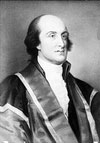1784-1807
The Early Republic
1784
James Madison returns to Montpelier, studies law, and ventures into land speculation without much success in either. Tours New York State with Marquis de Lafayette. Again serves in Virginia House of Delegates from 1784 to 1786.
1785
While member of Virginia House of Delegates, blocks all efforts to establish state support for churches, culminating in ratification of Statute for Establishing Religious Freedom.
1786
Attends convention on interstate trade in Annapolis, Maryland; decision made to hold convention the following summer to revise Articles of Confederation.
1787
Arrives in Philadelphia as part of Virginia delegation to Constitutional Convention; presents his Virginia Plan. Plan champions stronger national government operating directly for individual citizens rather than states. Document becomes building block for U.S. Constitution.
1787-1788
Member of the Continental Congress. Using name "Publius," Alexander Hamilton, John Jay, and Madison co-author The Federalist. These essays, published in newspapers and bound editions, argue for ratifying new Constitution.
1788
Argues for ratifying new Constitution at Virginia ratifying convention. Virginia becomes tenth state to vote for ratification (March).
1789
Elected to U.S. House of Representatives; serves until 1797. Against wishes of some leading members of nascent Federalist Party, sponsors series of constitutional amendments to safeguard individual rights. Congress chooses 12 of large number of proposed amendments to send to states for consideration; 10 amendments ratified—known as Bill of Rights.
1791-1792
Disagrees with Alexander Hamilton's proposal to establish Bank of the United States. Further breaks with Hamilton and his emerging Federalist Party over their support for Great Britain during its war with France. Recognizes that principles of Federalist Party, particularly regarding economics, are no longer his own. With Thomas Jefferson and some Anti-Federalists, Madison soon becomes leading figure in emerging Jeffersonian Republican Party (also known as the Democratic-Republican Party).
1794
After four-month courtship, marries (September 15) Dolley Payne Todd of Philadelphia, an attractive young widow who lost husband, John Todd, and one of their two children to yellow fever epidemic of 1793.
1795
Leads opposition to Jay Treaty with Great Britain. The treaty, negotiated by Chief Justice John Jay, attempted to settle disputes, including continued British military presence in the northwestern U. S. territory, trade in the West Indies and the seizure of goods and men from American vessels. Although widely unpopular, the treaty was ratified.
1797
Retires from U.S. House of Representatives. Returns with family to Montpelier to enjoy pleasures of private life and take over management of family plantation. John Adams elected president; Thomas Jefferson, vice president.
1798
Joins Jefferson in preparing Virginia and Kentucky Resolutions, designed to inform states about what Jefferson and Madison see as unconstitutional nature of Alien and Sedition Acts. No other states join opposition.
1799
Elected to Virginia Assembly and defends Virginia Resolutions—a rallying point for fellow Republicans.
1800
Prepares Report of 1800, which explains Constitution as compact that must be honored by states to be effective, and argues for literal interpretation of First Amendment. Federal government moves to Washington, D.C.
1801
Actions of Federalist Adams administration and subsequent anti-Federalist backlash allow Thomas Jefferson's election as president. Madison appointed secretary of state.
James Madison Sr. dies (February 28).
1803
Jefferson administration negotiates Louisiana Purchase from France. During tenure as secretary of state, Madison tries to uphold American neutrality in face of transgressions against American trade by both France and England, who are again at war. Supreme Court upholds right of judicial review in Marbury v. Madison. Lewis and Clark expedition sets out for the West.
1807
In effort to force Great Britain to accept American demands regarding trade and impressment of American seamen into British navy, Madison persuades Jefferson to seek passage of Embargo Act, a complete ban on foreign commerce. Its restrictions have intended effect, but at expense of temporarily destroying the very commerce that they were trying to save.

![]()
![]() Alexander Hamilton.
Alexander Hamilton.
print : mezzotint, color.
T. Hamilton Crawford. 1932.
Prints and Photographs Division. Library of Congress.
LC-USZC4-6423.

![]()
![]() John Jay.
John Jay.
photographic print.
1891.
Prints and Photographs Division. Library of Congress.
LC-USZ61-295.

![]()
![]() The foundation of American government.
The foundation of American government.
Photomechanical print: color.
Henry Hintermeister. c1925.
Prints and Photographs Division. Library of Congress.
LC-USZ62-995.

![]()
![]() [Detail] Mrs. James Madison (Dolly Payne).
[Detail] Mrs. James Madison (Dolly Payne).
Engraving.
Gilbert Stuart. Between 1804 and 1855.
Prints and Photographs Division. Library of Congress.
LC-USZ62-68175.